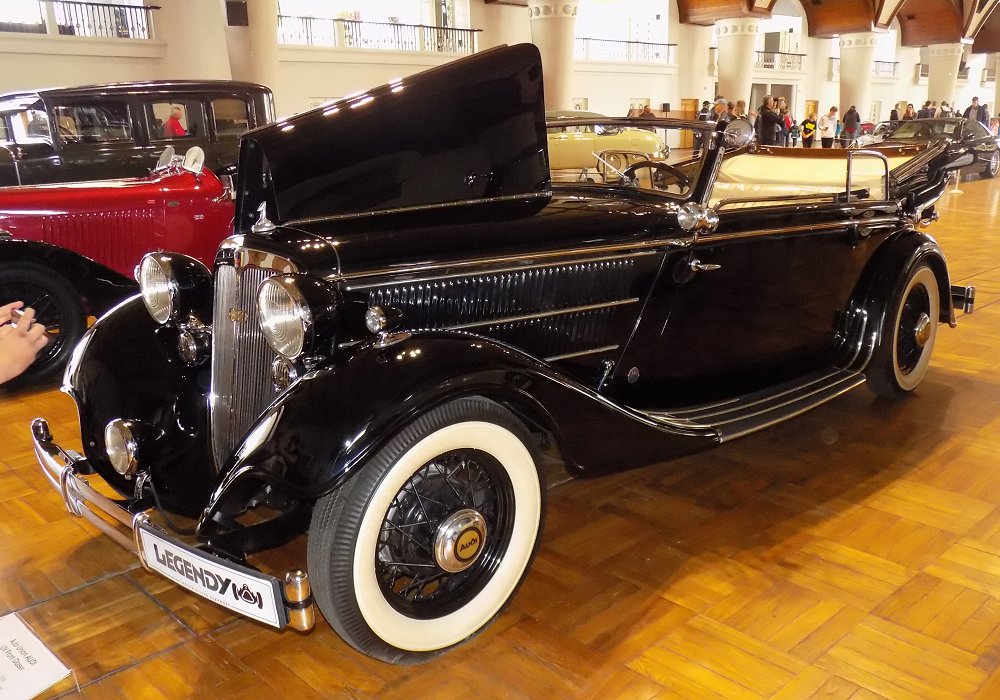The Audi Front UW Gläser 3.0 stands as a testament to automotive innovation, marking a pivotal moment in European car manufacturing. This 1933 masterpiece broke new ground by combining front-wheel drive with a six-cylinder engine — a configuration that would influence automotive design for decades to come.
Engineering ambition met artistic vision in this groundbreaking vehicle. The “UW” designation, standing for “umgekehrte Wanderer” (inverted Wanderer), hints at the ingenious solution of rotating the engine 180 degrees to enable front-wheel drive — a decision that would reshape automotive history.
Engineering Brilliance Meets Revolutionary Design
The heart of the Audi Front UW beats with remarkable innovation. Its 2995cc six-cylinder engine, featuring a 75mm bore and 113mm stroke, delivered 40 horsepower through an advanced overhead valve configuration. This powerplant represented more than just numbers — it showcased Audi’s commitment to pushing engineering boundaries.
The transmission system, specifically adapted for front-wheel drive, marked a departure from conventional wisdom. This groundbreaking drivetrain configuration improved traction and handling characteristics, setting new standards for automotive performance.
“The UW’s engine placement was revolutionary for its time. Even today, its engineering solutions continue to impress specialists,” notes Marcus Heidelberg, vintage Audi restoration expert at Classic Auto Bavaria.
The production process demanded exceptional precision, resulting in just 1,817 units being manufactured. This limited production run has only enhanced the model’s historical significance and collector value.
Fact!
The Audi Front UW's front-wheel-drive system influenced numerous subsequent automotive designs, including the layout of modern luxury vehicles. Its revolutionary engine placement technique is still studied in engineering schools today.
Aesthetic Excellence and Design Innovation
At 4,375mm long, 1,650mm wide, and 1,575mm tall, the Front UW Gläser 3.0 struck an imposing figure on the roads of 1933. The Gläser coachwork exemplified the finest traditions of German craftsmanship, with particular attention paid to aerodynamic principles — revolutionary for its time.
The cabriolet variant, especially, showcased the model’s versatility and luxury aspirations. Its elegant lines and balanced proportions created a visual language that would influence automotive design for years to come.
“Each surviving Gläser cabriolet tells a unique story of automotive artistry. The attention to detail in these cars is simply remarkable,” shares Elizabeth Whitmore, prominent classic car collector.
The interior appointments reflected a perfect balance between functionality and luxury, with high-quality materials and thoughtful ergonomics throughout.
Historical Reference!
The Gläser coachwork company, founded in Dresden in 1864, was renowned for creating some of the most elegant automobile bodies of the pre-war era. Their work on the Audi Front UW represents one of their finest achievements.
Historical Impact and Technical Legacy
The Front UW Gläser 3.0’s influence extends far beyond its initial production run. This model established Audi’s reputation for technical innovation and helped popularize front-wheel drive among luxury manufacturers.
Key technical achievements include:
- pioneering front-wheel drive with a six-cylinder engine;
- advanced OHV valve configuration;
- innovative weight distribution solutions;
- sophisticated chassis dynamics for its era;
- groundbreaking aerodynamic design elements.
This technical heritage continues to influence automotive design, with many modern vehicles owing their fundamental layout to the principles established by the Front UW.
Modern Significance and Collection Value
Today’s automotive enthusiasts recognize the Front UW Gläser 3.0 as a crucial milestone in car development. Its rarity and historical importance make it a highly sought-after collector’s piece.
Recent restoration projects have highlighted the model’s enduring appeal. The 2024 reconstruction of the Auto Union Type 52 Schnellsportwagen has renewed interest in this era of Audi innovation.
Important!
Only a handful of original Audi Front UW Gläser 3.0 models survive today, with authenticated examples commanding significant attention at international classic car auctions.
The Future Through the Lens of History
The spirit of innovation embodied by the Audi Front UW Gläser 3.0 continues to inspire. Its revolutionary approach to engineering challenges remains relevant in today’s era of automotive transformation.
Modern Audi engineers often reference the Front UW when discussing the company’s heritage of innovation. The model’s influence extends beyond mere mechanical design to encompass the broader philosophy of pushing technological boundaries.
Advantages and Limitations
| Pros | Cons |
|---|---|
| Revolutionary front-wheel drive system providing improved traction | Limited production run affecting parts availability |
| Advanced six-cylinder engine with sophisticated valve arrangement | Higher maintenance complexity compared to contemporary models |
| Elegant Gläser coachwork demonstrating superior craftsmanship | Relatively modest power output by modern standards |
| Innovative weight distribution improving handling characteristics | Challenging restoration process due to unique components |
| Historical significance enhancing collector value | Limited documentation of original specifications |
| Pioneering aerodynamic design elements | Higher fuel consumption compared to smaller engines |
| Sophisticated suspension system for its era | Complex drivetrain requiring specialized maintenance |
The Audi Front UW Gläser 3.0 represents a perfect synthesis of innovation and craftsmanship. While its technical complexity poses challenges for modern restoration, these same characteristics make it an invaluable piece of automotive history. Its influence on car design and engineering continues to resonate nearly a century after its introduction.

